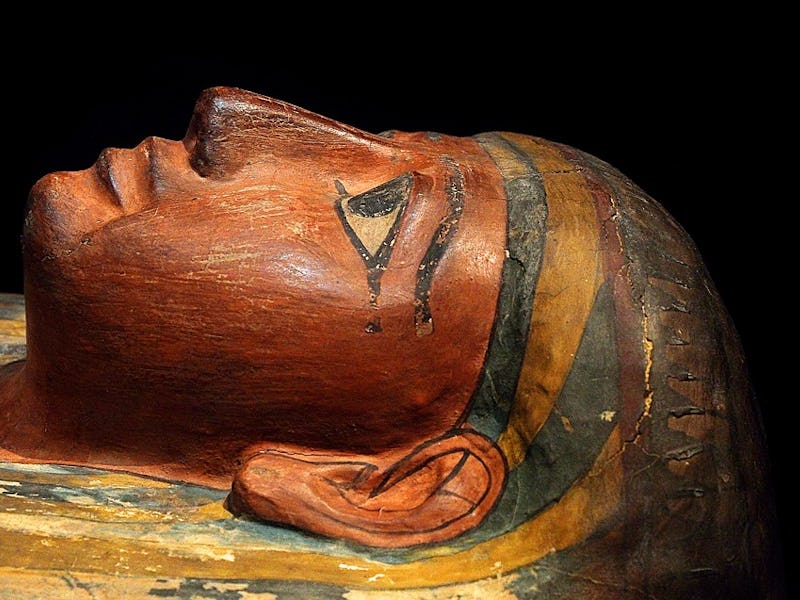Chemical Analysis Reveals the Millenia-Old Recipe for How to Make a Mummy
It smells "distinctly pleasant."

When you imagine an Egyptian mummy, you probably picture the embalmed body of a pharaoh, carefully wound in long strips of linen and laid in an ornate sarcophagus. But the mummies of an earlier age weren’t laid to rest in such decadence, suggesting to the scientists who found their bodies in shallow pits that they were preserved by chance, sand, and air. This “natural preservation” theory, however, might be laid to rest by a study published Thursday in the Journal of Archeological Science. Prehistoric Egyptian mummies, the authors say, were also treated with care.
This new study centers on Mummy S. 293, the earliest preserved body at the Egyptian Museum in Turin, Italy. No one knows when, where, or how S. 293 was discovered; the body was purchased by an unnamed dealer in 1901 and brought to the museum by its then director Ernesto Schiaparelli. Prior to this study, scientists couldn’t determine its age, how it died, or its sex. But it was presumed that its soft tissue was preserved because it was buried in an environment that naturally mummified it. Now, scientists have found that it actually was embalmed, proving that this preservation process took place 1,500 years earlier than previously thought. The mummy itself has been dated to 3,600 B.C.
Jana Jones, Ph.D., a study co-author and honorary research fellow at Macquarie University in Sydney, tells Inverse that “these findings will shake up theories about the beginnings of mummification.” Previous research conducted by Jones and her colleagues hinted that so-called prehistoric Egyptian mummies were treated with embalming substances, but ancient linen wrappings were the only concrete evidence for that theory. What makes S. 293 so special is that it has never undergone the conservation treatments applied by some museums or damaged by dealers, and so this mummy is perfect for analysis.
The mummy, S. 293.
“I wasn’t particularly surprised by the revelations, but relieved that here we had proof from a complete mummy corroborating our previous research,” says Jones. “I had suspected that prehistoric bodies were not quite as ‘natural’ as has been thought, but the chance of finding a body that had not been tampered with in a museum or by antiquities dealers, which would make valid scientific examination possible, was slight.”
Using chemical analysis, the team determined that S. 293 underwent an embalming process that included the use and mix of plant oil, heated conifer resin, an aromatic plant extract, and a concoction of plant gum with sugar. Study co-author and University of York research fellow Stephen Buckley, Ph.D. tells Inverse that this embalming recipe contains “the same antibacterial ingredients in the same proportions that would be used some 2,500 years later when the embalment ‘art’ was at its height.”
Buckley says that the chemical analysis process involved taking small samples of the mummy and analyzing them by chromatography-mass spectrometry, which “is where the ‘magic’ takes place.” This process separates the complex organic mixtures into their individual parts and allows the scientists to identify their specific “chemical fingerprint.” Those fingerprints allowed the researchers to back-engineer the original recipe for mummification.
A preserved foot, part of the mummy.
Today, the ancient resins still smell “distinctly pleasant,” says Jones, and we know now they weren’t just used to confer a nice smell to the dead. The identification of conifer resin within the mummification brew means that ancient Egyptians made use of the same antibacterial properties of the resin that living trees use to defend themselves from microbial attack and insects.
S. 293 is largely a mystery, but as we unravel his wrappings we learn more about the man beneath them. DNA extraction radiocarbon dating of his linens revealed that he died between the ages of 20 and 30, and DNA analysis showed that he didn’t die from a common disease like tuberculosis or malaria. His temple shows a healed fracture, but the team wasn’t able to determine whether he died from that injury.
“He died some centuries before the invention of writing,” says Jones. “However, the fact that expensive imported ingredients were used in his embalming, together with linen wrappings of high quality, would suggest that he held a privileged position in his society.”